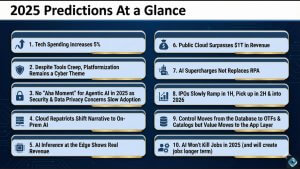Google’s announcement of the Agent Payments Protocol (AP2), developed in collaboration with over 60 industry heavyweights including Mastercard, PayPal, and Salesforce, is not merely a payment API update; it is the establishment of the missing trust layer for the emerging AI Agent Economy. The goal of AP2 is to be the first credible, vendor-agnostic infrastructure that formalizes the rules of engagement when money is involved in machine-to-machine (M2M) and agent-led transactions.
The fundamental assumption of e-commerce (a human clicking “buy”) is obsolete. As autonomous agents take on procurement, negotiation, and purchasing, IT and security leaders must pivot from solely controlling human access to securely governing agent autonomy.
Key Implications for the IT Decision Maker:
- Security & Audit: AP2’s core innovation, the Mandate system, aims to address enterprise concerns around fraud and accountability by creating a non-repudiable, cryptographically signed audit trail for every transaction.
- B2B Transformation: The protocol may enable autonomous procurement and dynamic license scaling for enterprise applications like those from ServiceNow and Google Cloud Marketplace, promising significant operational efficiencies.
- Payment Rail Agnosticism: By supporting both traditional credit/debit rails and emerging systems like stablecoins (via the A2A x402 extension), AP2 could future-proof the enterprise payment stack against a rapidly shifting financial landscape.
Building Trust into the Protocol
The immediate necessity for AP2 stems from the “crisis of trust” introduced by autonomous agents. Traditional payment systems are ill-equipped to answer three fundamental questions when an AI executes a purchase: Authorization, Authenticity, and Accountability. The goal of AP2 is to address these head-on, leveraging cryptographic proof to secure the chain of intent.
AP2’s Foundational Mandates
The protocol’s security is anchored in Mandates, or tamper-proof, cryptographically-signed digital contracts that define a user’s purchase instructions and authority. This mechanism is critical for both consumer and enterprise workflows:
- Intent Mandate (The Guardrails): This initial mandate records the user’s high-level instruction (e.g., “Buy concert tickets the moment they go on sale with a $150 limit”). For ITDMs, this is a form of pre-authorized, granular, digital-policy enforcement that dictates the agent’s spending scope.
- Cart Mandate (The Lock-In): In delegated tasks, the agent autonomously generates a Cart Mandate once conditions are met. This step acts as a final, immutable digital receipt of the exact item and price, removing the risk of “agent drift” or “hallucination” causing an incorrect purchase.
Analyst Take: If all goes to plan, the Mandate system moves security and accountability from a reactive process (dispute resolution after the fact) to a proactive, contractual one. CIOs must recognize that this verifiable credential system will soon become the standard for any high-value, autonomous transaction. Integrating AP2 is less about adopting a new payment method and more about adopting a new governance framework for AI-driven financial actions.
Unlocking New Enterprise Efficiencies and B2B Commerce
While Google’s announcement focuses on consumer use cases (smarter shopping, travel booking), the enterprise implications of a secure agent payment protocol are transformative, particularly in procurement and platform usage.
Strategic B2B Use Cases
- Autonomous Procurement: Enterprise agents may now be tasked with monitoring supplier prices, inventory levels, and contract terms. The agent could then autonomously generate a purchase order that is signed and transacted via AP2, ensuring all actions comply with the pre-approved Intent Mandate signed by a human procurement manager.
- Dynamic Software Scaling: AP2 aims to provide the transactional layer for AI agents to manage cloud and software consumption. For example, an agent monitoring application demand could automatically procure additional cloud licenses or scale a Google Cloud Marketplace solution, with the purchase being an AP2-governed transaction. This could enable real-time resource elasticity without manual procurement bottlenecks.
- Complex Coordinated Tasks: Imagine a supply chain agent identifying a disruption and, within a budget, automatically negotiating with a new logistics provider and paying for emergency inventory from an alternative vendor, all in one simultaneous, auditable, and non-repudiable transaction.
Analyst Take: The alignment with enterprise platforms like ServiceNow and Salesforce suggests that AP2 is engineered for B2B scale. For the Head of IT Operations, the protocol represents an opportunity to automate the long tail of low-value, high-frequency procurement tasks, freeing up the team to focus on strategic sourcing and vendor management. The initial integration challenge (connecting AP2 to legacy ERP and procurement systems) will likely spur a new market for AP2 integration services.
The Payment Future
AP2 is strategically positioned as a payment-agnostic layer, capable of riding on any underlying financial rail. This design choice is crucial for mitigating future technical risk and embracing financial innovation.
The Crypto Component
- Universal Support: AP2 is designed to support traditional methods (credit cards, bank transfers) and emerging decentralized payments, including stablecoins and cryptocurrencies, through extensions like the A2A x402 extension.
- Bridging the Divide: This dual-rail approach is pragmatic. It can allow enterprises to adopt the secure AP2 framework using their existing, familiar fiat systems while creating a seamless on-ramp to the faster, potentially lower-cost, and high-frequency stablecoin rail necessary for true M2M commerce.
Analyst Take: The embrace of Web3 payment mechanisms should be seen by ITDMs not as a niche feature, but as a strategic nod to the future of high-velocity micropayments. As agents begin to perform millions of small tasks (e.g., paying for API access, data scraping, or token consumption), the cost and latency of traditional payments will become a crippling bottleneck. AP2’s architecture aims to ensure that the enterprise will not need to re-engineer its security and governance protocols to capitalize on the next evolution of financial infrastructure. The open-source nature of AP2 is a call to action for all IT leaders to collaborate in building the necessary governance extensions to this foundational framework.



